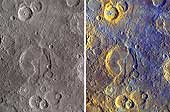|
COMETS EARTH JUPITER KUIPER BELT MARS MERCURY METEORITES NEPTUNE OORT CLOUD PLUTO SATURN SOLAR SYSTEM SPACE SUN URANUS VENUS ORDER PRINTS
PHOTO CATEGORIES SCIENCEVIEWS AMERICAN INDIAN AMPHIBIANS BIRDS BUGS FINE ART FOSSILS THE ISLANDS HISTORICAL PHOTOS MAMMALS OTHER PARKS PLANTS RELIGIOUS REPTILES SCIENCEVIEWS PRINTS
|
Related Documents
Download Options
Date Acquired: October 6, 2008 To the human eye, Mercury shows little color variation, especially in comparison to a colorful planet like Earth. But when images taken through many color filters are used in combination, differences in the properties of Mercury's surface can create a strikingly colorful view of the innermost planet. Shown here are two color images of Thakur, named for the Bengali poet, novelist, and Nobel laureate influential in the late 19th and early 20th centuries. The image on the left was produced by combining images from three WAC filters into red, green, and blue channels, as a general representation of the color seen by the human eye (though every person sees color slightly differently, as discussed for the full-planet color images.) The right image was created by statistically comparing and contrasting images taken through all 11 of the WAC's narrow-band color filters, which are sensitive to light not only in the visible portion of the spectrum but also to light that the human eye cannot see. This method greatly enhances subtle color differences in the rocks of Mercury's surface, providing insight into the compositional variations present on Mercury and the geologic processes that created those color differences. Visible on the floor of Thakur crater is the intersection of two ridges, seen here in unprecedented detail for the first time with MESSENGER's newly obtained images. Credit: NASA/Johns Hopkins University Applied Physics Laboratory/Carnegie Institution of Washington |
